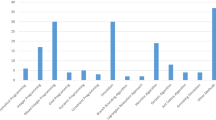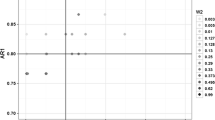Abstract
Scheduling of surgeries in the operating rooms under limited competing resources such as surgical and nursing staff, anesthesiologist, medical equipment, and recovery beds in surgical wards is a complicated process. A well-designed schedule should be concerned with the welfare of the entire system by allocating the available resources in an efficient and effective manner. In this paper, we develop an integer linear programming model in a manner useful for multiple goals for optimally scheduling elective surgeries based on the availability of surgeons and operating rooms over a time horizon. In particular, the model is concerned with the minimization of the following important goals: (1) the anticipated number of patients waiting for service; (2) the underutilization of operating room time; (3) the maximum expected number of patients in the recovery unit; and (4) the expected range (the difference between maximum and minimum expected number) of patients in the recovery unit. We develop two goal programming (GP) models: lexicographic GP model and weighted GP model. The lexicographic GP model schedules operating rooms when various preemptive priority levels are given to these four goals. A numerical study is conducted to illustrate the optimal master-surgery schedule obtained from the models. The numerical results demonstrate that when the available number of surgeons and operating rooms is known without error over the planning horizon, the proposed models can produce good schedules and priority levels and preference weights of four goals affect the resulting schedules. The results quantify the tradeoffs that must take place as the preemptive-weights of the four goals are changed.














Similar content being viewed by others
References
Storch JL (2005) Country profile: Canada’s health care system. Nurs Ethics 12(4):414–418
Health Canada (2005) Canada’s health care system. Retrieved From http://publications.gc.ca/collections/collection/h21-261-2005e.pdf
Jebali A, Alouane ABH, Ladet P (2006) Operating rooms scheduling. Int J Prod Econ 99:52–62
Alex Macario MD (2010) What does one minute of operating room time cost? J Clin Anesth 22(4):233–236
Dexter F, Epstein RH (2009) Typical savings from each minute reduction in tardy first case of the day starts. Anesth Analg 108:1262–1267
Brunner JO, Bard JF, Kolisch R (2009) Flexible shift scheduling of physicians. Health Care Manag Sci 12:285–305
Beliën J, Demeulemeester E, Cardoen B (2009) A decision support system for cyclic master surgery scheduling with multiple objectives. J Sched 12:147–161
Gupta D, Denton B (2008) Appointment scheduling in health care: challenges and opportunities. IIE Trans 40(9):800–819
Begen MA, Queyranne M (2011) Appointment scheduling with discrete random durations. Math Oper Res 36(2):240–257
Tan YY, Elmekkawy TY, Peng Q, Wright B (2007) Analysis of surgical patient flow at Winnipeg Health Science Center. In the Proceedings of the 2007 CDEN and CCEE Conference, Manitoba
Beliën J, Demeulemeester E (2007) Building cyclic master surgery schedules with leveled resulting bed occupancy. Eur J Oper Res 176:1185–1204
Adan I, Bekkers J, Dellert N, Vissers J, Yu X (2009) Patient mix optimization and stochastic resource requirements: a case study in cardiothoracic surgery planning. Health Care Manag Sci 12:129–141
Denton B, Miller AJ, Balasubramanian HJ, Huschka TR (2010) Optimal allocation of surgery blocks to operating rooms under uncertainty. Oper Res 58(4-part-1):802–816
Vanberkel PT, Boucherie RJ, Hans EW, Hurink JL, van Lent WA, van Harten WH (2011) Accounting for inpatient wards when developing master surgical schedules. Anesth Analg 112(6):1472–1479
Vanberkel PT, Boucherie RJ, Hans EW, Hurink JL, van Lent WA, van Harten WH (2011) An exact approach for relating recovering surgical patient workload to the master surgical schedule. J Oper Res Soc 62(10):1851–1860
Dexter F (2012) A brief history of evidence-based operating room management: then and now. Anesth Analg 115(1):10–11
Cardoen B, Demeulemeester E, Beliën J (2010) Operating room planning and scheduling: a literature review. Eur J Oper Res 201(3):921–932
Rais A, Viana A (2010) Operations research in healthcare: a survey. Int Trans Oper Res 18:1–31
May JH, Spangler WE, Strum DP, Vargas LG (2011) The surgical scheduling problem: current research and future opportunities. Prod Oper Manag 20(3):392–405
Blake JT, Donald J (2002) Mount Sinai hospital uses integer programming to allocate operating room time. Interfaces 32(2):63–74
Santibáñez P, Begen M, Atkins D (2007) Surgical block scheduling in a system of hospitals: an application to resource and wait list management in a British Columbia health authority. Health Care Manag Sci 10(3):269–282
Testi A, Tanfani E, Torre G (2007) A three-phase approach for operating theatre schedules. Health Care Manag Sci 10:163–172
Ogulata SN, Erol R (2003) A hierarchical multiple criteria mathematical programming approach for scheduling general surgery operations in large hospitals. J Med Syst 27(3):259–270
Pariente JMM, Torres JMF, Cia TG (2009) Policies and decision models for elective case operating room scheduling. Paper Presented at the 2009 international conference on computers and industrial engineers, Troyes, France
Blake JT, Dexter F, Donald J (2002) Operating room manager’s use of integer programming for assigning block time to surgical groups: a case study. Anesth Analg 94:143–148
Astaraky D, Patrick J (2015) A simulation based approximate dynamic programming approach to multi-class, multi-resource surgical scheduling. Eur J Oper Res. doi:10.1016/j.ejor.2015.02.032
Cochran JK, Bharti A (2006) Stochastic bed balancing of an obstetrics hospital. Health Care Manag Sci 9:31–45
Tan YY, Elmekkawy TY, Peng Q, Oppenheimer L (2007) Mathematical programming for the scheduling of elective patients in the operating room department. In the Proceedings of the 2007 CDEN and CCEE Conference, Manitoba.
Marcon E, Dexter F (2007) An observational study of Surgeons’ sequencing of cases and its impact on postanesthesia care unit and holding area staffing requirements at hospitals. Anesth Analg 105(1):119–126
Marcon E, Smolski N, Luquet B, Viale JP, Kharraja S (2003) Determining the number of beds in the postanesthesia care unit: a computer simulation flow approach. Anesth Analg 96(5):1415–1423
Ivaldi E, Tanfani E, & Testi A (2003) Simulation supporting the management of surgical waiting lists. Discussion Paper Della Sezione Di Economica Politica E Studi Economici Internazionali. Retrieved From www.diem.unige.it/21.pdf
Marjamaa RA, Torkki PM, Hirvensalo EJ, Kirvelä OA (2009) What is the best workflow for an operating room? A simulation study of five scenarios. Health Care Manag Sci 12:142–146
Denton B, Gupta D (2003) A sequential bounding approach for optimal appointment scheduling. IIE Trans 35(11):1003–1016
Cardoen B, Demeulemeester E, Beliën J (2009) Optimizing a multiple objective surgical case sequencing problem. Int J Prod Econ 119:354–366
Fügener A, Hans EW, Kolisch R, Kortbeek N, Vanberkel PT (2014) Master surgery scheduling with consideration of multiple downstream units. Eur J Oper Res 239(1):227–236
Augusto V, Xie X, Perdomo V (2010) Operating theatre scheduling with patient recovery in both operating rooms and recovery beds. Comput Ind Eng 58(2010):231–238
Fei H, Meskens N, Combes C, Chu C (2009) The endoscopy scheduling problem: a case study with two specialised operating rooms. Int J Prod Econ 120:452–462
Houdenhoven MV, Oostrum JM, Hans EW, Wullink G, Kazemier G (2007) Improving operating room efficiency by supplying bin-packing and portfolio techniques to surgical case scheduling. Anesth Analg 105(3):707–713
Lamiri M, Xie X, Dolgui A, Grimaud F (2008) A stochastic model for operating room planning with elective and emergency demand for surgery. Eur J Oper Res 185:1026–1037
ILOG, ILOG (2012) ILOG CPLEX 12.4 user’s manual. ILOG, Inc, Sunnyvale
Acknowledgments
[The corresponding author deleted this section to protect author information]
Compliance with ethical standards
ᅟ
Conflicts of interest
Disclosure of potential conflicts of interest
Funding
The research of M.F. Baki has been partially supported by Research and Teaching Innovation Fund (RTIF), Odette School of Business, University of Windsor (Grant no. 809335) and Natural Sciences and Engineering Research Council (Grant No. 813000). The research of the Xiangyong Li has been partially supported by the Natural Science Foundation of China (Grant no. 71101105, 71432007), Program for New Century Excellent Talents in University (Grant no. NCET-13-0424), research fund for doctoral program of higher education of China (Grant no. 20110072120013), Shanghai philosophical and social science program (Grant no. 2011EGL004), and the Fundamental Research Funds for the Central Universities. Thanks are due to three referees for comments that improved the manuscript.
Author information
Authors and Affiliations
Corresponding author
Appendix: Instance data
Appendix: Instance data
Tables 8, 9, 10, and 11 show the probability that a patient of surgery team stays in the recovery area for different surgical speciality. As stated earlier, patients of each surgery team stay in the recovery unit for at most 5 days.
Rights and permissions
About this article
Cite this article
Li, X., Rafaliya, N., Baki, M.F. et al. Scheduling elective surgeries: the tradeoff among bed capacity, waiting patients and operating room utilization using goal programming. Health Care Manag Sci 20, 33–54 (2017). https://doi.org/10.1007/s10729-015-9334-2
Received:
Accepted:
Published:
Issue Date:
DOI: https://doi.org/10.1007/s10729-015-9334-2




